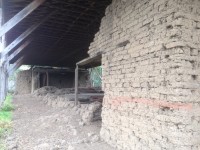As westward expansion began to slowly creep into Mexican territory by the mid 1830s, men, women and children made their way west across the country, hoping for a new beginning in California. In the early years, westward expansion on the California Trail was a man’s endeavor. Wives and children often remained home until the man of the family established a new home in the western frontier. The one thing both Mexican and American inhabitants shared: musket balls.
The musket ball has been in use for over 500 years. The manufacture of musket balls creates characteristics that can be described and ultimately identified as such. The musket balls used in old Sonoma were not hollow based, but simply round lead balls of various calibers. Balls were generally made in two parts, revealing a casting seam running down the middle of the ball. Particularly if a mold is misaligned when the lead is poured, the seam is that much more visible. There is a channel which provides access for the molten lead known as a sprue. The caliber of the ball is determined by the size of the mold.
For most, a new beginning came with a great price. Generally, at least one person perished along the way with each traveling group. Causes of death along the Oregon-California-Mormon Trails, between 1847 and 1869, include “cholera, Indian attacks, freezing, run-overs, drownings, shootings, and scurvy.” Other casualties included lightning strikes, childbirth, snakebites, falling trees and wagon mishaps.
The 2,000-mile California Trail extended from various Missouri River towns, following the mighty valleys of the Platte, North Platte and Sweetwater Rivers. There were several routes the intrepid explorers might take once reaching Wyoming, Idaho and Utah. The California Trail wound its way to present day Wells, Nevada where followers found the Humboldt River. They followed the Humboldt until reaching the Truckee, which led to the Carson Range and Sierra Nevada. The Sierra Nevada was the last big obstacle before reaching the gold fields in the eastern foothills.
The travelers augmented their food supply by hunting along the way. Antelope, deer, elk, buffalo, trout, elk, bear, ducks and geese, were prized as they provided something different than beans, coffee, ham and biscuits. Fires were started at each camp and a healthy supply of buffalo chips, collected and dried along the way, made great fire starters.
For my younger readers, buffalo chips did not come in sour cream and onion varieties.
In the 13th century, the hand cannon was developed, consisting of a metal tube closed on one end. Gunpowder was used to discharge the canon, hurling a round metal ball through the air. Eventually, this technology spread across the world, but proved rather ineffective for both hunting and for more nefarious purposes. The traditional musket ball was replaced in the mid-19th century my muzzle-loading rifles. By the late 19th century, breech-loading rifles were developed that used brass cartridges.
In the 1840’s a typical wage for an honest days work was $1.00. Unless one was fortunate enough to get a job on the trail, guarding livestock or driving wagons, most could not afford the six-month journey across the country. Food for a family of four averaged about $150 and the cost of other supplies could far exceed $500 for the trip. The beauty of the musket ball is that they could be manufactured cheaply by all gun owners, and if you owned a gun, you owned a musket mold. A simple mold would cast six balls at one time and lead was dirt cheap, albeit a little heavy.
From time to time, folks around town find musket balls. Like any other artifact, each ball has a story. Musket balls, like square nails, broken glass, buttons and a myriad of other ancient treasures, provide us with a connection to the past. These artifacts are like time machines, windows, allowing our imaginations run wild with part fact and part fiction.


Be First to Comment